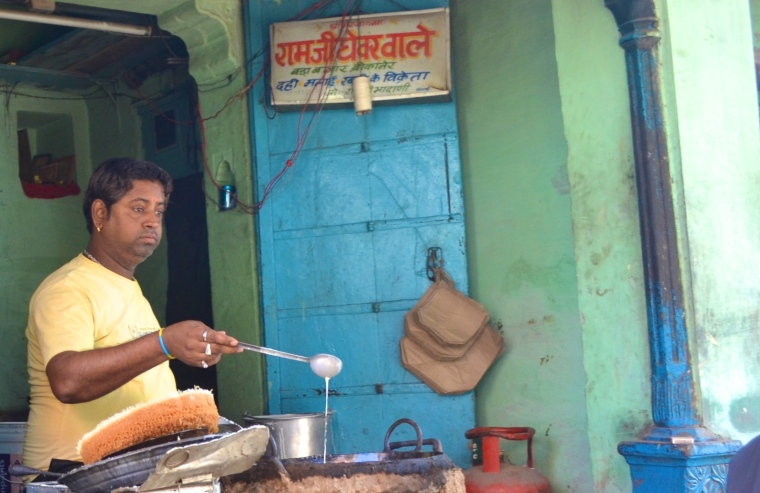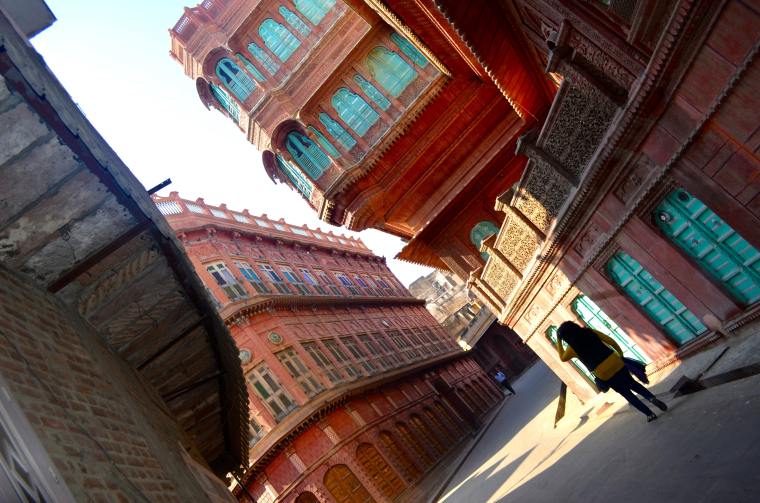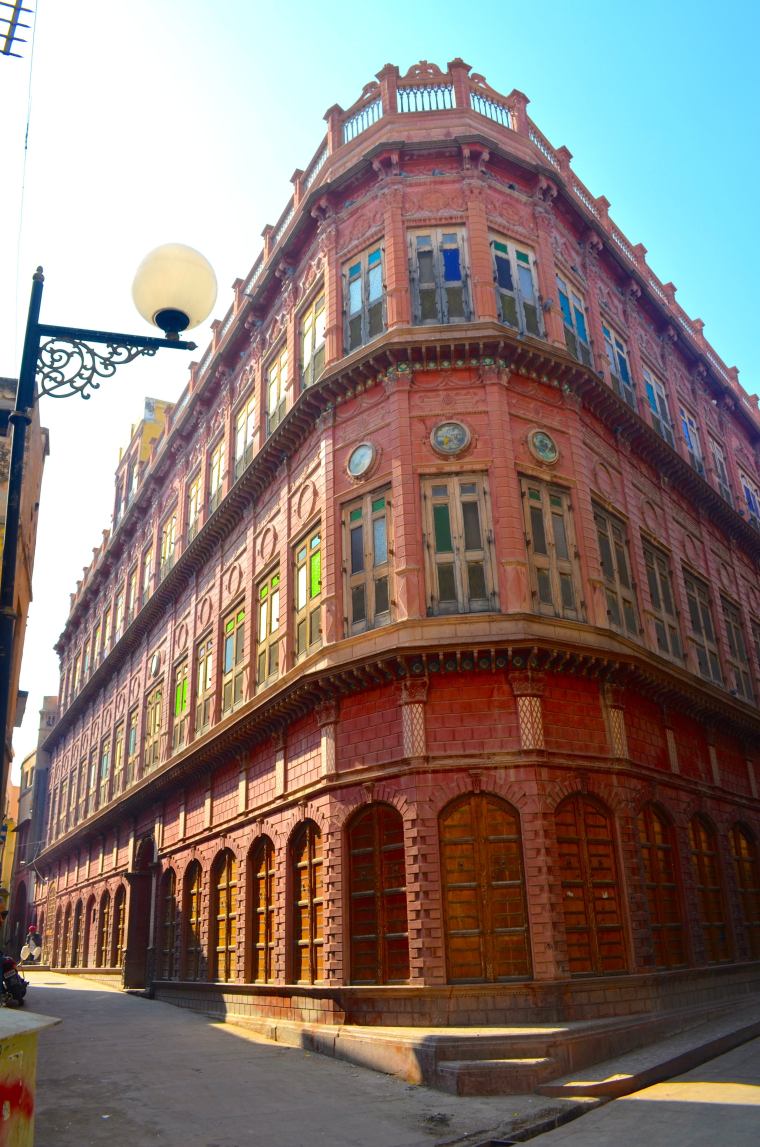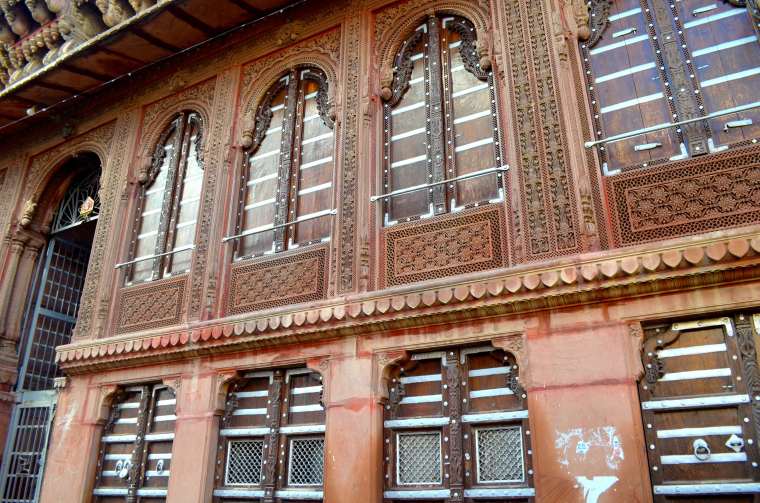Beauties and bounties in the bylanes of Bikaner…
“You won’t be able to find them on your own.” The hotel manager dismisses our valiant declaration of self-exploration with a mysterious smile. “I’ll arrange an auto rickshaw to guide you. The lanes are too narrow for a car.” Intrigue levels: brim high.
Our driver, Wali, nods knowingly, when I show him the google pictures in my phone. We climb into the well-padded back seat of our colourful three-wheel drive towards the oldest part of the city. At 11 am, its still a lazy morning in the marketplace. Steamy curls rising from chai cups, brooms swooshing across verandahs and biscuit-laden carts rumbling along to designated spots. The man stirring hot milk at Ramji Ghewar Wale sweet shop seems absent-minded…still not fully awake yet?

Wali manoeuvres expertly into lanes that get narrower and tighter. No cars here. No heritage structures. Only ordinary, cramped, whitewashed houses. The heart of the city, and the oldest neighbourhood in all of Bikaner hides some of the most unexpected treasures one can imagine. A dozen odd turns and the lanes broaden without warning. I uncap my camera lens…chin up. Within a few seconds, Wali comes to a halt and suggests that we walk. Anticipation build-up. Around a corner a few meters ahead, I spot something familiar. Exactly like one of the pictures I had shown Wali! Its one of those gorgeous havelis of Bikaner!


And there are more of them ahead! Generously proportioned, many adjacent to each other. Graceful. Ornate. Exquisite. These traditional mansions (from Arabic haveli, meaning ‘private space’), were once luxurious residences of wealthy merchants who migrated to more prosperous towns for business. Built as havens for rest and symbols of status between 17th and 20th centuries. Now abandoned, proud testimonies to the stunning artistry of the past, pieces of priceless heritage, still largely hidden from public eye. And this is the most famous cluster…the Rampuria Group of Havelies built by Balujee Chalva.
The entire area is spotlessly clean, paved streets lined with magnificent red Dulmera-stone townhouses. Not a soul in sight. Except a bearded photographer diligently at work. And one elderly moustached guard in a vivid red turban and spotless white dhoti-kurta. He scrutinizes us from his chair, never moving a inch. I touch the delicately designed iron street lamp and observe the lime-aqua window frames, the fine patterns on the walls of the buildings. These fabulously created mansions are deserted. Is this a movie set? It takes me a few minutes to believe it is all real.


“There are many, many more ahead,” Wali urges us. The next couple of hours are a daze of dazzling splendour…we weave in and out of lanes, ogling at the havelis. Not all are as famous or in impeccable shape, or in the cleanest of areas. But the marvel continues, unabated. I can’t stop taking pictures.
A pigeon coos over the carved chajja (sloping eaves) of an intricate jharokha (window), unmindful of its arty perch. I study the jharokas…they’re high up, to protect from swirling dust storms, perhaps. The decorative, textured surface and the jaali work (lattice) in wood or stone served a dual purpose back in those days…a safe peek-spot for ladies of the house to look out unseen by outsiders and an ingenious cooling effect much needed in this hot climate on the fringes of the Thar Desert, where summer temperatures often hover around 50 degree centigrade. The sloping chajjas…more protection from the heat and a natural drain for rainwater.


I look closer. Flowers and leaves dominate the design palate, so exquisite, like precious jewellery. Compensating for what the arid desert landscape around lacks. Columns embellished with lotus (symbolising worship), peacocks (symbolising the monsoon, a blessing in this dry land). Some doors with simple panels, others with elaborate carvings. Solid wood latches and knockers before the time of doorbells. Not so subtle indicators of beauty, valour, wealth. Even in some smaller havelis, the exteriors are ornate…a camouflage for cramped interiors, maybe. Even the streets are oriented in the East-West direction at right angles…the direction of dust storms? Architecture made a lot of sense back then.


I visualise the interiors. A traditional central courtyard, from where all spaces emerged, earmarked for all family activities, ceremonies and rituals. A sacred tulsi (basil) plant worshipped daily to bring prosperity to the house. The lung space, the light well of the house, bordered by an arcade to keep the interiors cool. Demarcating separate areas for men and women, even separate diwankhanas (drawing rooms), where guests were received. The richer one heavily adorned with art, valuable murals, glass mirrors, paintings of gods and goddesses, wooden ceilings with stunning Usta gold embossing. Some of them converted into heritage hotels. Others out of bounds.


A resident stepping out of his haveli notices my camera and dismisses the auto-rickshaw with a haughty wave. “Will you park that to a side, you’re blocking our entrance.” Heavy iron grills hide the ornate carved door and wooden laminates have replaced the delicate lattice work windows. In these narrow bylanes, ancient art is co-existing with modernity and convenience for now…but for how long?

As we drive out of one of the city gates, my mind is overflowing with images of the lace-like borders beneath the windows, the pretty curvature of arches, and the decorative details of the filigree panels. Bikaner’s old city is an open museum of dozens of miniature palaces. Unlike its more popular cousin cities in Rajasthan…Jaipur, Udaipur, Jaisalmer and Jodhpur, this one is still waiting in the wings. Till then, pigeons coo. And peace prevails.



Woow.. The havelis look so well maintained. I have traveled to a few places in the Shekhawati region but the havelis are in quite a dismay there. I m glad to discover this treasure through your post. I haven’t visited Bikaner yet, so there goes another must-visit place to my pending list for Rajasthan 🙂 Btw, loved the picture with green windows.
LikeLiked by 1 person
Bikaner is simply a stunning surprise. The havelis are unreal. Wait for my next post on Junagarh Fort. That was a masterpiece too
LikeLiked by 1 person
I’d only ever heard about the amazing food in Bikaner. Stands to reason that where good food prevails, the place obviously has a deep and rich heritage too! These Havelis are beautiful!
LikeLiked by 1 person
Real treasures, hidden away. Must-visit..
LikeLike
Such great storytelling here– I could feel the anticipation. And the havelis are gorgeous! Those colors are unbelievable. It amazes me that deserted buildings still look so good. I would think people still live there, just from the look of them.
LikeLiked by 1 person
Thank you so much for your comment 🙂 I agree…the most surprising aspect is actually how good they look.
LikeLike
This area is completely new to us and just underlines the reasons why we want to continue travelling. The architecture looks amazing, the carvings and designs. Decorative but with an underlying practical purpose.
LikeLiked by 1 person
Don’t you enjoy learning the whys of architecture. I do!
LikeLike
These havelis of Bikaner are simply marvellous architectures. I could gaze on them forever. Nice that you choose a lazy morning to explore them. I wish I could experience spending a night in one of these
LikeLiked by 1 person
Have you been there? You can actually spend a night in one of the few that have been converted into heritage hotels.
LikeLike
I am so loving the architecture and photos in this post. You want me to wander these streets and check out the amazing windows. Love the write up. Safe travels 🙂
LikeLiked by 1 person
I’m an architecture buff, so Bikaner havelis were the prime reason for our visit.
LikeLike
Wowy!!! It’s like going into the lanes of Old delhi only you’re rewarded with more colourful buildings and intricate architecture. Lovely post and a wonderful way to explore the real city. The havelis look pretty well kept too.
LikeLiked by 1 person
Imagine the area was so empty at 11 am….we would never enjoy such luxury in Old Delhi except on a Sunday 🙂
LikeLiked by 1 person
Wow! Your pictures are so beautiful and unique! Seems like the perfect hidden gem!
LikeLike
Thanks so much! It was a delightful trip.
LikeLike
Love this post! Havelis were my favourite part of Bikaner as well…in fact, I went there thrice in the week that I spent in the city, and came back with such wonderful memories!
LikeLiked by 1 person
They were so unreal, weren’t they? Bikaner was a surprise package. We went to Junagarh and Gajner. Did you?
LikeLike
Cant believe they are so well maintained. So colorful and striking detail in the architecture. Clearly depicts the magic of India.
LikeLiked by 1 person
You couldn’t be more right..India is magical, in so many different ways
LikeLike
Thanks for the history lesson! They remind me a bit of some of the mansions and doors I saw while travelling in Zanzibar a few years back. Great photos!
LikeLiked by 1 person
Would love to see pictures of those Zanzibar mansions..imagine a similarity with Indian architecture
LikeLike
Wow! I can see why you wanted to go and see these. I had no idea they existed. Simply stunning. And rather sad that so many are abandoned. I love Seeibg the intricate architecture on buildings like this
LikeLiked by 1 person
Residential areas in many old towns all over the world are being deserted as people move in search of more conveniences. Sad yes, but I’m glad at least the heritage is preserved.
LikeLike
Your post reminded us of the Havelis in Jaisalmer, the Havelis here too have some of the amazing intricate lattice work. We haven’t yet been to Bikaner but if we had to the old city exploring these beautiful Havelis will definitely be on the list. From your pictures, it’s evident that the old city isn’t much frequented good that you had enough space to explore the heritage.
LikeLiked by 1 person
I’m sure Jaisalmer havelis would have been similar to some of these. Others were really unusual and in impeccable shape. Yes, the best part was that we had the area all to ourselves.
LikeLike
It pained me to see the neglect some of these havelis are facing. Little by little they are crumbling not noticeable in a span of few months but definitely yearly comparisons will show the damage taking place. I too loved my tour there.
LikeLiked by 1 person
Preservation of the past sometimes takes a backseat to convenience and economic considerations. One sees this in many countries all over the world. But its good that things are getting better 🙂
LikeLike
Wow, the havelis of Bikaner sure are gorgeous! I love all the details and colors, especially the teal shutters on the first photo. Would love to check them out sometime!
LikeLiked by 1 person
And you would love it all..
LikeLike
They are just gorgeous and they all look so good and well kept! I love the details of the flowers and the colors are awesome! I had no idea even what a havelis was before I read this so thank you for sharing! Travel always teaches us things!
LikeLiked by 1 person
Each new travel is a new discovery. One learns so much, even about one’s own country and culture 🙂
LikeLike
Beautiful and indepth post
I enjoyed reading this
LikeLiked by 1 person
Thank you! Glad you enjoyed it.
LikeLike
Oh, what a beautiful and colorful discovery! The kind of lanes, with surprise at the end that I like to explore . . Is it not possible to go inside?
LikeLiked by 1 person
It is possible to go inside, but these are private home and we did not want to invade privacy.
LikeLike
Wow what an adventure to search for these havalis. They were all so beautiful and looked almost new for something so old. I love the second last photo, with the curved balconies.
LikeLiked by 1 person
I love all the pictures…in fact I have so many more, but one has to draw the line somewhere 🙂
LikeLike
Nicely written to draw someone in, and I like that your prose is full of detail. Kinda neat that you focused on a particular sight (building) that was your hunt for that day. Did you get to see any interiors?
LikeLiked by 1 person
Thanks so much…appreciate your thoughtful comment, as always. 🙂
LikeLike
It’s always exciting to discover hidden treasures. These mansions are stunning and I can certainly understand why you made the effort to seek them out. I bet you were glad to have a guide in the end that could take you to exactly the right place!
LikeLiked by 1 person
Yes, a guide was needed, because the mansions are scattered around narrow lanes over a large neighourhood. But its not impossible to do it alone, if you know where to go.
LikeLiked by 1 person
I love the lattice-work that adorn the havelis…simply gorgeous. I think your driver found some beautiful ones for you.
LikeLiked by 1 person
Yes, the intricacy of the patterns really boggles the mind.
LikeLike
Oh wow! Another thing to add to my India bucket list 🙂
LikeLiked by 1 person
And the list gets longer..
LikeLike
Pictures of Haveli’s are marvelous. Bikaner is place for historical monuments.
LikeLiked by 1 person
Glad you liked the post.
LikeLiked by 1 person
Wow what a great place to explore and good photography opportunity here to those architectural designs are so amazing. id love to see the interiors too!
LikeLiked by 1 person
Yes, Bikaner is a photographer’s delight, like the rest of Rajasthan, and India 🙂
LikeLike
I felt like I was reading a novel…Your writing is really good! The description was so detailed that along with your photos, it was like I was walking with you! Sounds like you had a great day and you gained experiences to have for all your life with you. These buildings look so old and so well preserved at the same time!
LikeLiked by 1 person
Thanks a million for that comment. It was a memorable experience, seeing and learning about those havelis.
LikeLike
I have never heard of this area and I dont know much about this region but this is why I am sourcing information from blogs like yours so that i can plan my future trips. It is so much better to hear such detailed stories from those that have traveled there first hand. I love the photos
LikeLiked by 1 person
India is such a vast country that its virtually impossible to decide what to see and what to skip. But you will love the experience
LikeLike
The way you write makes me feel as though I’m right there with you! I hadn’t heard of Bikaner before but will add it to my list of places to visit when I return to India someday!
LikeLiked by 1 person
Thanks a million. I hope you are able to visit Bikaner, or some part of Rajasthan someday to see for the its magic for yourself 🙂
LikeLike
This makes me so nostalgic for India! It’s so colourful and the patterns are so intricate. I’m always fascinated to see how ancient architecture exists alongside modern life, it’s so interesting to see.
LikeLiked by 1 person
As Indians, we also keep discovering our country more every single day 🙂
LikeLike
Wow, that’s surprising and amazing – it looks surreal, in India – such a beautiful place that seems abandoned and so quiet. The architecture is beautiful – the balconies remind me of the wooden carved architecture of Tbilisi in Georgia. I’ve been to many places in India – but I must visit this site when I’m there next!
LikeLiked by 1 person
I just looked up Tbilisi, Georgia. You added a great destination to my travel list, thanks!!
LikeLike
Wow, you really found a hidden gem! Hard to believe that most of these havelis are abandoned. I don’t suppose that any of them allowed visitors to tour the inside?
LikeLiked by 1 person
They are personal residences and unless its a haveli converted into a heritage hotel, it does seem like an invasion of privacy.
LikeLike
Those havelis are just stunning! I missed going to the old part of Bikaner when I visited but, like you, I know I would’ve spent lots of time ogling and photographing these grand dames!
LikeLiked by 1 person
Ah…I hope you can make it again, sometime. Guess you’ve been to Jodhpur..
LikeLike
The havelis are amazingly beautiful. I love the different designs. How lucky that you had a guide to help you find them all. I hope to do the same thing when I finally get to go to India!
LikeLiked by 1 person
I hope you do. Its quite easy to navigate, but reaching the right spots takes local knowledge.
LikeLike
Bikaner is magical! Went there last year around Jan. Did you venture to the rat temple?
LikeLiked by 1 person
No, we did not. Beauty attracts me more 🙂
LikeLike
Bikaner and its Havelis! I have heard so much about them and how their grandeur is just for namesake now. Loved ever single click of yours! 🙂
LikeLiked by 1 person
I think their grandeur has only magnified with time 🙂
LikeLike
Learning something new is the best part of any travel and your article and the the you wrote it had me hooked from the start. Your passion is clear in this article and I certainly enjoyed along with the pictures.
LikeLiked by 1 person
Thank you so much for your comment. Have you travelled to India?
LikeLike
Now this is something I should do when I visit Bikaner next. These look amazing and so so beautiful. Loved all your pictures and descriptions. And still in awe of the workmanship back then.
LikeLiked by 1 person
This is the biggest reason anyone should visit Bikaner..aside from the Junagarh Fort and the fabulous drive, of course..
LikeLike
Your adventure getting to these Havelis is exactly what I hope to have next month when I go to India. I’m glad you shared this post because I don’t think I’d have any idea about the importance of these buildings, their history and architectural significance otherwise.
LikeLiked by 1 person
I’m glad it helped. What’s your itinerary like?
LikeLike
This is way more than cool. Its like, a must-have property to have in life. My hubby and I would love to have a Palatial home like this. 😀
LikeLiked by 1 person
Maybe you can go and stay in one of the heritage hotels in the area to experience how it feels 🙂
LikeLiked by 1 person
Oh! That would be awesome. ☺
LikeLiked by 1 person
I love your storytelling style! Makes it easier to picture the whole experience. The architecture is really amazing! A place worth visiting 🙂
LikeLiked by 1 person
Thanks so much! Hope you go someday.
LikeLike
Well captured and described.Though we did Bikaner some months ago we skipped this bit because of the hot & humid climate at that time. Have kept the exploration of Bikaner on foot for one of the winters!
LikeLiked by 1 person
Winters would be ideal, yes. We went in January too. You can add Gajner Palace when you go, a picturesque lake setting worth seeing.
LikeLiked by 1 person
Yes. Gajner is best in winter
LikeLiked by 1 person
I had never heard of this place before and after seeing the great pics I’m glad I visited your blog. Very very nice! Awesome pictures too
LikeLiked by 1 person
Thanks so much. Hope you can go and see for yourself.
LikeLike
Wow this sounds amazing! YOur storytelling had me feeling I was right there with you! That architecture looks absolutely stunning. I am definitely adding Bikenar to my bucket list!
LikeLiked by 1 person
Thanks a million 🙂
LikeLike
I was living in India last year and was working for a travel agency. I saw a lot of Rajasthan but not Bikaner. I already wanted to come back but your post makes me want to come back even more if it’s even possible. Bikaner sounds really beautiful with lovely havelis. I will definitely consider visiting on my next trip !
LikeLiked by 1 person
Ah! India is really vast, and even locals cannot claim to have seen everything there is to see. But its so wonderful that you were able to explore a lot of Rajasthan..its one of the crowning glories of our country.
LikeLike
Your storytelling is incredible, and these havelis are exquisite, indeed. The bright colors, the grandeur of them…I’d love to see them myself someday. Also, some of them remind me of the architecture here in Madrid.
LikeLiked by 1 person
Thanks so much for your comment. I always get inspired by old architecture.
LikeLike
The city is such a beauty. I was supposed to go last month 😦 . The Havelis are splendid and a photographer’s delight. I can spend entire day or say week just clicking pictures of the city 🙂
LikeLiked by 1 person
I know!!! And its still underrated. Loved the havelis…they are essentially the reason we went.
LikeLike
Bikaner is indeed a lesser known gem, a place that flourishes in the shadow of cities like Jaipur and Jodhpur. But probably because of that very fact it is all the more alluring. The rich and regal history of Rajasthan dances in the lanes andd bylanes of this desert town and there is something to discover around every bend and corner. We were there a couple of months ago and loved the place.
LikeLiked by 1 person
It was really a surprise package, wasn’t it!
LikeLike
I’m going, that’s all there is to it. 🙂
LikeLiked by 1 person
So glad you were inspired to add it to your list 🙂
LikeLike
Visited the place a decade ago. Was dumbfounded. You have expressed your appreciation so beautifully. I am glad that the grandeur survived these years. I had seen hundreds of these havelis then in those tiny lanes. Our guide said that there were a total of about 400- 600 of those gems. What would be your estimate on the numbers today as a few were being demolished right before our eyes although most of the grandest like the Daga chowk and rampuria havelis remained intact . Also do try and visit a place called Khichan near jodhpur. Absolutely breathtaking havelis to see there as well.
LikeLiked by 1 person
Its so good to exchange travel notes on a place that we amazed us equally. I guess nothing has changed much in the last decade, despite renovations/demolitions. There seemed to be hundreds of them still around. Will keep in mind Khichan…have to go to Mandawa too.
LikeLike